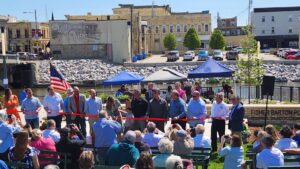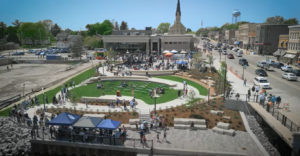
Official ribbon-cutting ceremony at Bentzin Family Town Square, Watertown WI in May 2023.
The city motto of Watertown, WI is “Opportunity Runs Through It.” Watertown has been intentionally and incrementally creating that opportunity through long-term redevelopment of brownfields and under-utilized areas in its riverfront downtown corridor. Ten years of planning later, the Bentzin Family Town Square is the redevelopment that ties the community’s vision together.
Watertown utilized funding from the Wisconsin Department of Natural Resources (DNR) Wisconsin Assessment Monies (WAM) and Knowles-Nelson Stewardship Grant, along with over $2 million in additional funds to spur the redevelopment of a former hair salon, pharmacy, restaurant, karate studio and printing press. A Phase II Environmental Site Assessment and subsequent site investigations identified petroleum contaminated soil prior to cleanup and demolition.
Bentzin Family Town Square is designed to be open, inviting, and beautiful space that provides a central place for community activities and gatherings for guests of all ages and abilities. The multi-purpose space serves many purposes such as:
- Providing a portal to the Rock River with an accessible boat and kayak launch
- Celebrating the unique and rich history of the city with a regionally produced art installation
- Promoting tourism and community activity with a plaza for music performances, markets and food trucks
- Creating a space for youth activities with a splash pad and interactive water art piece
- Connecting the library to the downtown corridor with a new central entrance and ‘front porch’ leading directly to the town square
Watertown government officials recognized the importance of community buy-in and support early in the planning process. They communicated proactively through community meetings, a dedicated website, and a robust social media plan which included a monthly production video. Even the youngest Watertown residents were included in planning; Watertown held a K-5 grade art contest to collect ideas for amenities to add to the square. A program events coordinator position was created to organize and manage year-round activities, which demonstrated continued investment in the area. Future town square expansion plans include a 101-unit luxury multi-family development with approximately 2,800 square feet of commercial and retail space. Construction is set to begin September of 2023.

Bentzin Family Town Square is a monument to collaboration; stakeholders from private and public sectors committed to the project. Credit: Watertown Redevelopment Authority.
Watertown city officials state that investment in redevelopment “has already paid dividends by increasing downtown activity, opening doors to more employment opportunities, and encouraging other business owners to update their properties.”
Cleaning up and redeveloping a brownfield property takes time, but with Green Team help from the DNR and the support of state financial partners, a successful redevelopment is possible.
The DNR has a wide range of financial and liability tools available to help local governments, businesses, lenders, and others clean up and redevelop brownfields in Wisconsin, including Ready for Reuse financial awards, which may be used for environmental cleanup and the WAM Program, which partners with communities to help clean up and redevelop often run-down or underused properties that detract from a community’s potential. The Wisconsin Brownfield Success Stories Map showcases some of the many communities that have effectively cleaned up and repurposed brownfield properties.
Feeling inspired? The DNR is happy to help you and your community with your cleanup and redevelopment efforts. Request a Green Team meeting and start the conversation.



